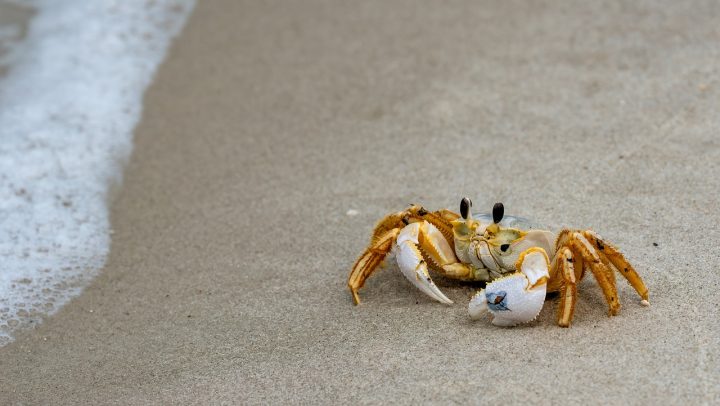Utilizing shellfish in combating gum disease

According to the WHO, periodontal disease, also called gum disease, in its severe form affects around 19% of the global adult population and poses a serious economic burden on society. If ignored, gum disease can lead to the destruction of the bone surrounding the teeth. This destruction of bone can even cause teeth to loosen and fall out, severely reducing the quality of life of affected patients.
Chitosan is a biopolymer derived from chitin. It has been extensively researched and is proven to possess antibacterial and antifungal properties. Chitosan’s journey to the dental office starts in the sea, where chitin can be found abundantly in crustaceans (shrimp, lobsters, crab shells, etc.). The chemical production of chitosan is very complex and usually involves several steps. Everything starts with demineralization and deproteinization of crustaceans’ shells, followed by bleaching and further chemical transformation of the product. After that, chitosan can be used in medicine and dentistry in several different ways.1,2
It turns out that chitosan has a wide variety of uses in dentistry. It can be incorporated into toothpaste, topical gels used in oral surgery, and even dental restorative materials such as glass ionomer cement used as a filling material after caries removal. Chitosan is frequently used as a basis for a hydrogel, which is effective as a delivery mechanism of antibiotics or bioactive agents.2,3
More recently, chitosan has been successfully used in periodontology, a branch of dentistry that deals with gum diseases. Several peer-reviewed articles describe how a professionally used brush made of chitosan fibres oscillating, moving back and forth in a regular rhythm at the infection site, can help reduce initial-stage inflammation and bleeding around dental implants without damaging surrounding tissues.4,5
The same chitosan brush has been used and deemed effective as a first-stage treatment before surgery in patients who have shown symptoms of advanced gum disease and bone loss around their dental implants. It’s also been successfully used in patients who, despite undergoing regular periodontal maintenance by a specialist periodontist or dental hygienist, still exhibit some residual inflammation-caused defects called periodontal pockets in their gums.5,6
This method, in combination with other antiseptic or regenerative agents, holds a promising potential for more successful non-surgical treatment in the near future.
In a new study, planned as a co-project of the University of Turku FINDOS programme and Riga Stradiņš University Department of Doctoral Studies, we aim to find out if an oscillating chitosan brush in combination with regenerative agents such as enamel matrix derivatives, bioactive molecules extracted from porcine fetal tooth material, can improve the healing of gum disese-induced bone defects between the roots of molars.
Anete Vaškevica
The writer is a PhD student at the University of Turku and Riga Stradiņš University. She is an Acting lecturer at the Riga Stradiņš University Department of Conservative Dentistry and Oral Health and an enthusiast of minimally invasive, non-surgical periodontal treatment.
References:
- Zhao, D., Yu, S., Sun, B., Gao, S., Guo, S., & Zhao, K. (2018). Biomedical Applications of Chitosan and Its Derivative Nanoparticles. Polymers, 10(4), 462. https://doi.org/10.3390/polym10040462
- Cicciù, M., Fiorillo, L., & Cervino, G. (2019). Chitosan Use in Dentistry: A Systematic Review of Recent Clinical Studies. Marine drugs, 17(7), 417. https://doi.org/10.3390/md17070417
- Ikinci, G., Şenel, S., Akıncıbay, H., Kaş, S., Erciş, S., Wilson, C. G., & Hıncal, A. A. (2002). Effect of chitosan on a periodontal pathogen Porphyromonas gingivalis. International journal of pharmaceutics, 235(1-2), 121-127.
- Wohlfahrt, J. C., Aass, A. M., & Koldsland, O. C. (2019). Treatment of peri-implant mucositis with a chitosan brush-A pilot randomized clinical trial. International Journal of dental hygiene, 17(2), 170–176. https://doi.org/10.1111/idh.12381
- Zeza, Blerina & Wohlfahrt, Johan & Pilloni, Andrea. (2017). Chitosan brush for professional removal of plaque in mild peri-implantitis. Minerva stomatologica. 66. 10.23736/S0026-4970.17.04040-7.
- Hussain, B., Karaca, E. O., Kuru, B. E., Gursoy, H., Haugen, H. J., & Wohlfahrt, J. C. (2022). Treatment of residual pockets using an oscillating chitosan device versus regular curettes alone-A randomized, feasibility parallel-arm clinical trial. Journal of Periodontology, 93(5), 780–789. https://doi-org.db.rsu.lv/10.1002/JPER.21-0496
